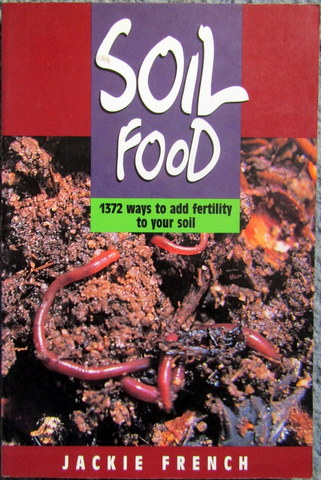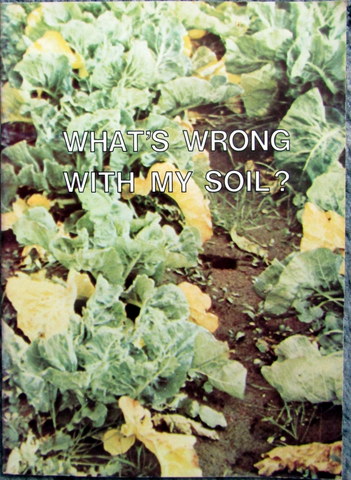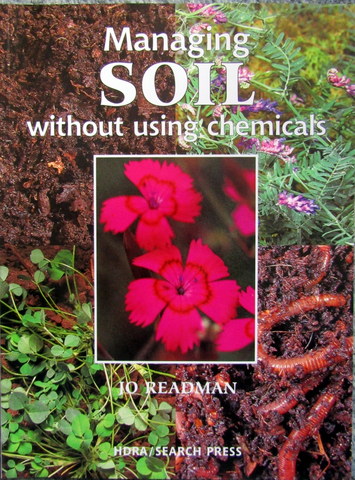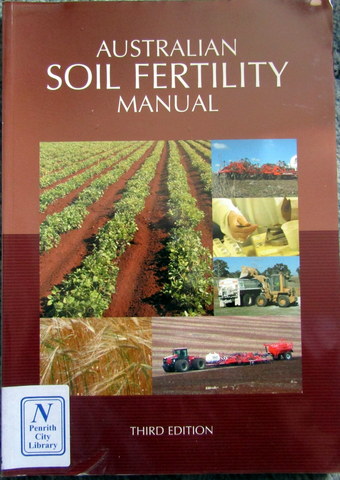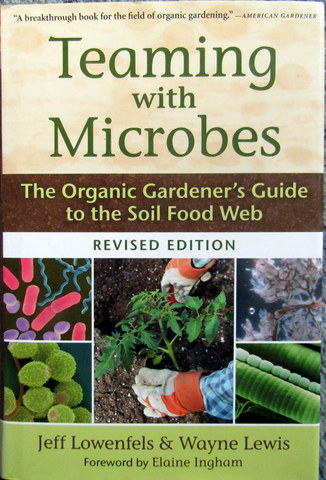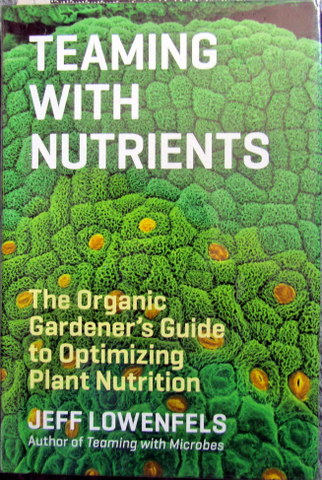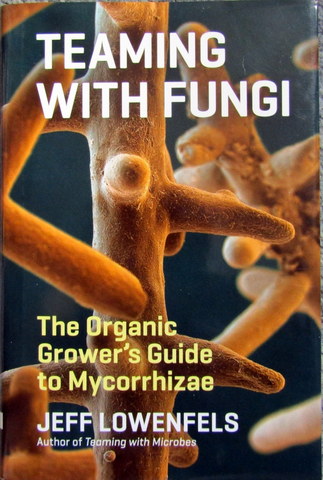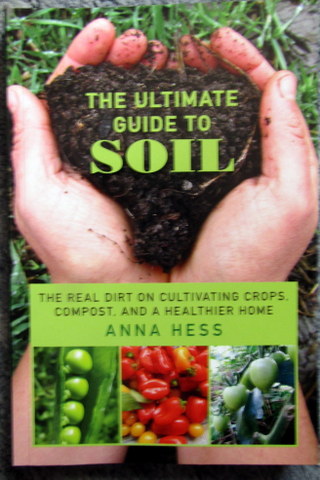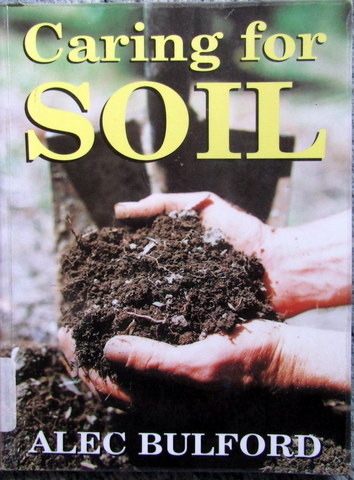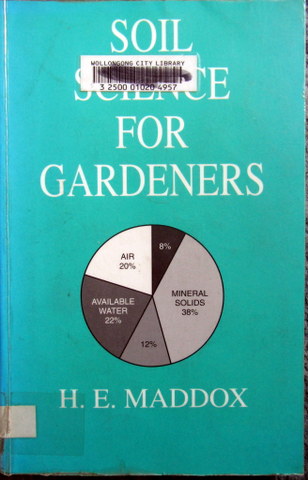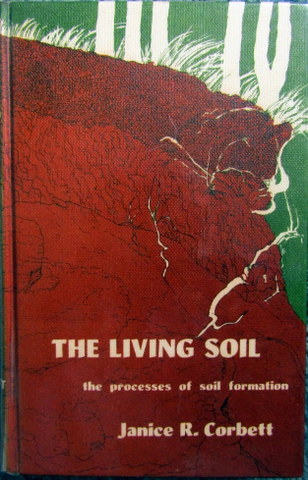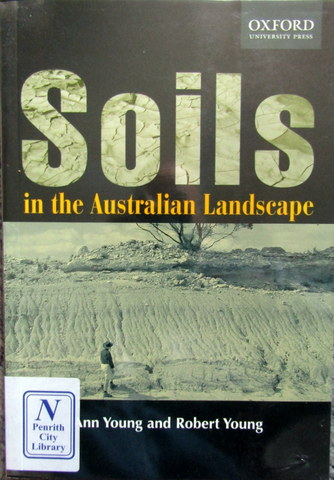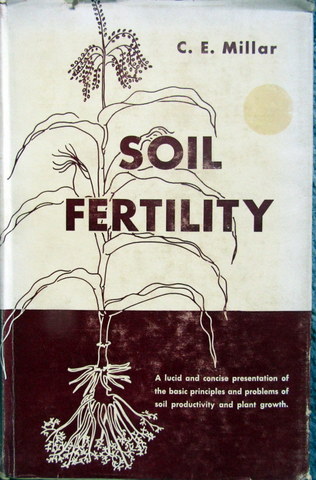Soil Food – Jackie French – Aird Books (AUS) 1995 ISBN 0 947214 44 5 – This is a good basic book on soil fertility. It starts off with correcting soil deficiencies and a discussion of pH then moves onto which plants need what elements then moves on to fertilisers (organic and inorganic) and how to use them. There are then 4 chapters talking about a different fertility maintenance technique in each one: green manure, manure, compost and mulch. The last chapter covers case studies in fertility management in particular circumstances such as new gardens, gardening on steep slopes, established fruit and veg gardens, dry gardens, eroded land etc. The book has a few line drawings.
What’s Wrong with My Soil? – Kevin Handreck – CSIRO (AUS) 1978 ISBN 0 643 02169 8 – This booklet is part of the CSIRO Discovering Soils booklet series, but this is the only one in my collection. It is only 28 pages long and covers 3 types of soil problems – chemical, physical and biological. The first section on chemical problems is a good summary but looks at inorganic fertilisers to fix problems. The second section is much smaller and covers a bit about clay soils well and also mentions soil temperature and shade as physical problems. The biology section is more about pests and diseases, not much on soil biota. The booklet has colour and B&W photos as well as line drawings.
Managing Soil Without Using Chemicals – Jo Readman – HDRA/Search Press (UK) 2004 ISBN 1 84448 011 9 – This is a good book for the UK with limited application in Aus (as far as soil type info). It coves what soil is and talks about what soil is made of, soil life, the different types of soil and soil structure. The next chapter covers how to manage your soil including organic matter, cultivating your soil, pH and soil nutrients, and drainage. There is a section in the back on soil problems at a glance. Lots of colour photos and line drawings.
Australian Soil Fertility Manual – Graham Price (ed.) CSIRO & Fertiliser Industry Federation of Australia (AUS) 2006 ISBN 0 643 09021 5 – As you would expect from the publishers, this is main stream agriculture and not in the slightest bit organic! However, it does have a lot of information about soil nutrients and what they do in soil. Nitorgen, potassium and phosphorous get a chapter each, then another chapter on calcium, magnesium and sulphur, and one for micronutrients. There is some on soil, water and plant analysis for nutrient determination and also on fertilisers and the environment, including the impact of heavy metals. A few line drawings and lots of tables.
Teaming with Microbes – Jeff Lowenfels & Wayne Lewis – Timber Press (US) 2010 ISBN 978 1 60469 113 9 – If you are interested in soil, You Need This Book! It summarises the scientific research of the last 15 years or so (prior to the writing of the book) on the importance of the soil biota (soil life) and how it is crucial to the plants we grow. The first half of the book covers the different types of life in the soil and their impact on the soil. The second half talks about how you can apply soil web science to your soil and plants to get the best outcome. There is even a cheat sheet at the back summarising the important points in applying the science, but it is worth reading cover to cover and is a great read. Lots of colour photos and line drawings.
Teaming with Nutrients – Jeff Lowenfels – Timber Press (US) 2013 ISBN 978 1 60469 314 0 – This is the second book in the series and I found this much heavier going. It starts off with biology, botany and plant cells then covers plant nutrients and how they (and water) move through plant cells. Subsequent chapters cover the importance of soil testing and the factors affecting nutrient availability for the plants (eg pH), culminating in the final chapter on what and when to feed plants. The book is organic in approach and the as chapter provides organic fertiliser recipes for annuals, veg, perennials, trees etc. and how best to apply them. Lots of colour photos.
Teaming with Fungi – Jeff Lowenfels – Timber Press (US) 2017 ISBN 978 1 60469 729 2 – This is the third (and currently last) book in this series. Again, this gets quite technical and if you anything like me you will have lots of fun trying to pronounce the names of the various mycorrhizae! The book covers the impact of mycorrhizal fungi on agriculture, horticulture, silviculture, hydroponics and lawns. There is also a chapter on how to harvest mycorrhizal fungi from nature and then grow it at home so you can then use it as an inoculum to grow healthier and more productive plants! Some line drawings and colour photos.
The Ultimate Guide to Soil – Anna Hess – Skyhorse Publishing (US) 2016 ISBN 976 1 63450 770 7 – This is a great “first book on soil” for the beginner, although some of the more specific stuff on soil types will apply mainly in the US.. It starts out with a series of soil tests that can be done at home to help you characterise your soil, following by recommendations on professional soil tests. The second part covers small scale no till basic techniques including starting a no till garden, solarisation, no dig management techniques and even aquaponics. The third section covers balancing nutrients (organically) and pH and the fourth section covers organic soil additions like compost, manure and wood chips. Lots of colour photos.
Caring for Soil – Alec Bulford – Kangaroo Press (AUS) 1998 ISBN 0 86417 918 9 – A good general book with a small amount of information on a large amount of soil aspects. The introduction covers information about characterising your soil then there are chapters on salinity, compost and water in your soil. The book then moves through information on the major nutrients (N, P, K) then covers lime and biochar (called agrichar® in the book). It finishes off with a discussion on soil carbon, soil silicon, garden pests and potting mixes. There are a few colour photos.
Soil Science for Gardeners – H. E. Maddox – Freshnet Press (AUS) 1998 ISBN 0 9593361 8 4 – This one is a bit more on the technical side but still understandable by the interested layman. It covers mostly the physical and chemical aspects of soil with almost no mention of soil biota. The section on fertilisers is not particularly organic although organic matter in the soil and compost is covered. The section on fertilising recommendations for vegetables, fruit and flowers refers to chemical fertilisers only.
The Living Soil – Janice R. Corbett – Martindale Press (AUS) 1969 ISBN not listed – This one is a high school general text on soil and soil formation all over the world. As one would expect from its age, there is no mention of soil biota at all, it is the physical and chemical aspects of soil and its formation which is covered.
Soils in the Australian Landscape – Ann and Robert Young – Oxford University Press (AUS) 2001 ISBN 0 19 551550 1 – This is a “big picture” book rather than a backyard soils book, but is sets the context of how a local soil fits into the soils of Australia. The book starts out with a discussion of Australian soils in general and the processes of how they were formed, how soils are characterised and named and the features of Australian soils in various parts of the continent. This is followed by sections on how water interacts with the soil and microorganisms interact with the soil. There are then chapters discussing old and hard soils, soils of high agricultural value, soils of forests and rangelands and finally soils around cities. There is a two page appendix on nifty soil tests you can do at home to assess you own soil. There is a section giving 32 colour plates and a few line drawings.
Soil Fertility – C. E. Millar – John Wiley & Sons Inc. (US) 1955 ISBN 978 8176221 13 9 – This is my copy, but it seems that it was been reissued in another format in 2013. This is a fairly comprehensive and scholarly work on soils, covering soil nutrients, colloids, pH, organic matter, NPK, calcium, magnesium and sulphur and the micro nutrients. There are also chapters on soil deficiencies and determining plant nutrient needs, soil organisms, green manures and crop residues, animal manures and commercial fertilisers. There are also two unusual chapters at the end, one on rotations and farming systems and the final one a summary of old US field experiments from the late 1800s and early 1900s. Probably not much use to the backyard grower but interesting nevertheless. The book has a very small number of black and white photos and the odd line drawing or table.



